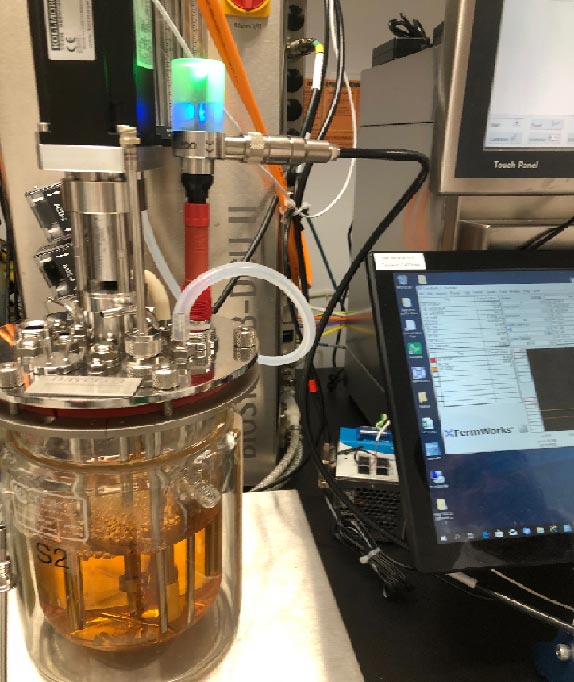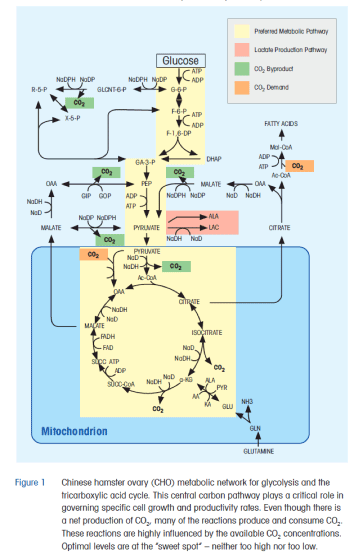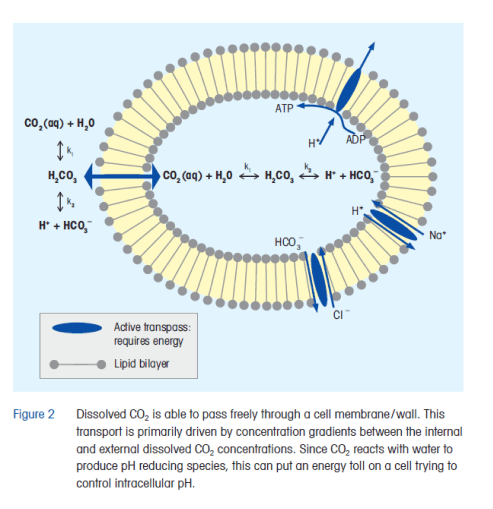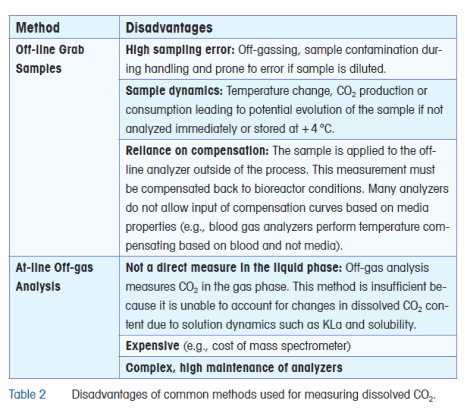- CO2 as a metabolic indicator
- Impact of CO2 on Extracellular and Intracellular pH
- Dissolved Carbon Dioxide Measurement & Control
It has become industry practice to keep a close watch and refined control on pH and dissolved O2, in conjunction with parameters including pressure, temperature, and aeration rates. We’ve also seen a growing necessity to monitor CO2 gas levels within process cultures real-time, both small and large scales. As CO2 gas affects the flux in key metabolic pathways as well as extracellular/intracellular pH, the dissolved CO2 concentration can significantly impact growth and productivity rates and maximize yield. High CO2 content can be toxic to mammalian cells, thus requiring certain CO2 levels for proper metabolic function.
Mettler-Toledo offers inline CO2 sensors. We recently helped a global biopharmaceuticals company based in the San Francisco Bay area to successfully integrate inline dissolved CO2 measurement with their bioreactor. Using the digital InPro 5000i dissolved CO2 sensor and the M100 SM Bluetooth multi-parameter transmitter device to access real-time diagnostics information, Optimal Biotech Group helped optimize their cell culture process by increasing product yield and eliminating offline sampling for their human biotherapeutics.

CO2 as a Metabolic Indicator
Dissolved carbon dioxide is an important metabolite produced and consumed in numerous metabolic reactions. Dissolved CO2 levels can significantly influence overall metabolic reaction fluxes key for high growth and productivity. All cells, anaerobic or aerobic, produce and consume CO2 within several metabolic networks. Many of these reactions, which occur in series, are reversible and diffusion driven. If the CO2 concentration is too high (toxic) or too low (reaction limiting), the CO2 producing or consuming reactions negatively impact the overall metabolic reaction flux.
For example, Figure 1 shows an aerobic central carbon metabolic network consisting of glycolysis and the tricarboxylic acid (TCA) cycle (also known as the citric acid cycle or Krebs cycle). It is well documented that the preferred pathway (highlighted in yellow) of converting glucose to pyruvate for utilization in the TCA cycle is the most energy efficient. This pathway is highly active and plays a critical role in governing specific cell growth and productivity rates. Within this pathway, CO2 is produced and consumed at multiple reversible and irreversible steps that occur in series. Sub-optimal CO2 concentrations would reduce the overall reaction flux of the preferred pathway.

Impact of CO2 on Extracellular and Intracellular pH
Dissolved carbon dioxide reacts with water to form carbonic acid which dissociates to produce a hydrogen ion resulting in a reduction in pH (Equation 1). Intracellularly, this reaction can also be modulated enzymatically. 〖CO2 + H2O H+ +〖HCO3– Equation 1 Dissociation reaction of CO2 in water.
Intracellular and extracellular pH has a significant bearing on physical and chemical reactions (e.g., metabolism, molecule stability), as well as on the types of processes a cell expends energy on performing. The lipid bilayer of a cell wall generally modulates the transport of polar or charged molecules (e.g., ions, sugars) across it. However, some uncharged polar molecules such as CO2 are able to permeate freely through the membrane. The ease for dissolved CO2 to enter a cell and, once inside, alter the intracellular pH, emphasizes the importance of the extracellular dissolved CO2 concentration.
Inside the cell, CO2 reacts with water to produce a hydrogen ion. This bypasses the cell’s mechanism used to control hydrogen ion concentration (CO2 can act as a biological Trojan horse!). The intracellular pH change caused by undesired CO2 levels results in the cell expending more energy towards pH control and reducing the resources used for cell growth and production of the desired protein, as shown in Figure 2. Controlling extracellular dissolved CO2 is one of the few control levers available for influencing intracellular pH.

Dissolved Carbon Dioxide Measurement & Control
The optimal operating range for dissolved CO2 concentration for CHO cell cultures has commonly been reported as 5 – 20 %, but the true optimal range depends on the specific process and recombinant cell line being used. CO2 control can be particularly important in scaled-up processes due to the very high total cell counts produced that can result in quick CO2 accumulation.
Despite the criticality of CO2 levels in cultivation media, this measurement has drawn little attention in the past. One reason for this has been the lack of reliable sensors and measuring methods. Many legacy processes use an off-line or at-line CO2 analyzer to measure CO2 because an inline CO2 sensor that remained stable after sterilization cycles had not been available. At-line and off-line measurements are not efficient for the measurement of CO2 (see Table 2). Therefore, many processes had to be designed with loose CO2 control leading to high variability and sub-optimal productivity.

Measuring CO2 inline eliminates many of the disadvantages associated with the at-line and off-line methods discussed in Table 2. Mettler-Toledo’s InPro 5000i dissolved CO2 sensor employs a potentiometric carbon dioxide electrode (Severinghaus electrode) that measures exactly the same dissolved CO2 partial pressure as the cells encounter. This method ensures errors from sampling are eliminated and metabolic changes in dissolved CO2 concentration affecting system dynamics will be reflected in the measurement.

Dissolved CO2 measurement can be complex because of the many ways carbon dioxide interacts within a biological model (see Table 3 for common ways that CO2 concentrations can be managed in bioprocessing).
